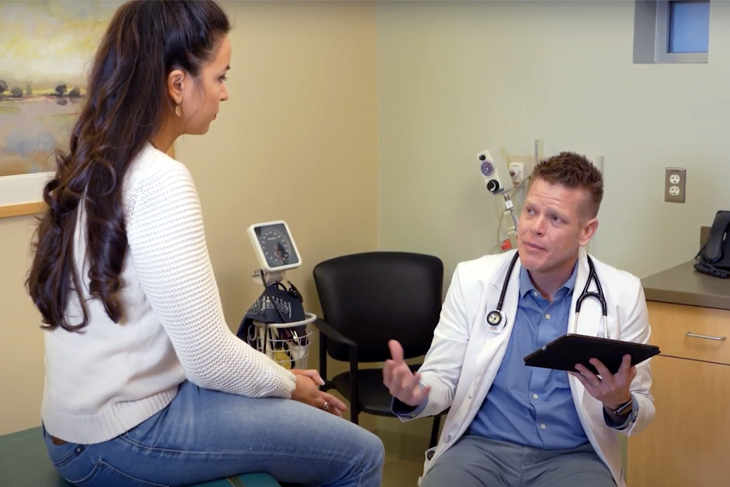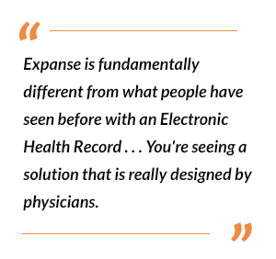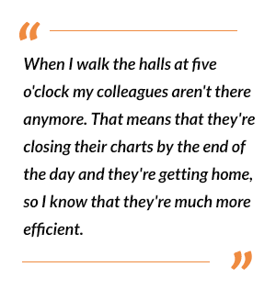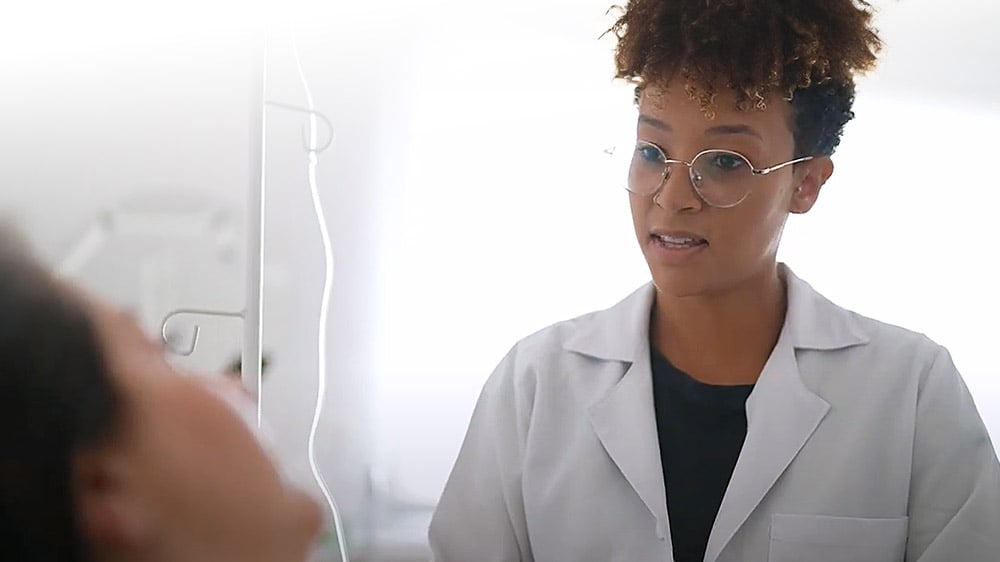
Recently, MEDITECH's Carol Bird had an opportunity to sit down with Dr. Doug Kanis, an Internist and CMIO at Pella Regional Health Center (Pella, IA). They discussed how Expanse's intuitive design, mobility, and interoperability helps physicians increase efficiency and improve patient care. The excerpts below are a few highlights from their conversation. To learn more about his experience using Expanse, watch our video interview with Dr. Kanis.
Carol: Can you tell us a bit about how you're leveraging the mobility of Expanse? How does mobility benefit you and your patients? Has it changed the way you interact with patients?
Dr. Kanis: I can get everything I need at the point of care – wherever that may happen to be – and this makes it easy to sit with patients, have a really good conversation about their condition, and that really improves patient care because it improves patients’ understanding of their conditions.
For example, I had a case where the patient could not come in for a visit for a variety of reasons, and I was able to go into her home, sit down with her and her family and show them the results of a cervical spine MRI. That technology, having that information at my fingertips – it really helped them understand the diagnosis and the prognosis and use that understanding to make the decisions that they did – decisions that were much more appropriate.
Moreover, I’m able to integrate information from multiple areas together into one place. That integration is really important because it makes all the information readily available at the point of care, wherever the patients may be. If they come into the ER, I know the ER doctor is going to have the right medication list. They’re going to have the right allergy list. They’re going to have my note available. They’re going to have all their lab test results available. And that enables physicians to provide the best care for their patients.
Carol: You mentioned how patients can make more appropriate decisions when they have a better understanding of their information. Has MEDITECH's Patient and Consumer Health Portal been helpful in keeping them informed?
Dr. Kanis: MEDITECH’s portal has been great for several reasons. One is that it’s remarkably beneficial to assist with communication between patients and the care team, and you always want to engage with your patients. So for example, a ton of my patients go down south for the winter, and they’re not able to communicate with my clinic so well through the phone system and such so they found it to be a really good way to communicate with us. They're sending messages, they're scheduling appointments, they can request refills, see their allergies, their medications, their problem list -- so it’s been a great way for patients to view their information as well. And as people use it, it becomes more and more popular. I love it when patients come in and say “this has been on my problem list - we need to change it or adjust it.” They’ve become more engaged and active. So it’s another way to keep patients informed about their health and conditions.
Carol: So it seems like your patients have been adopting the new technology. How about your colleagues? How easy has the EHR been for them to use?
Dr. Kanis: Expanse is fundamentally different from what people have seen before with an Electronic Health Record. I've seen MEDITECH take this solution and go  through multiple different user groups to really maximize the intuitiveness of this product. The intuitiveness is fantastic. You're seeing a solution that is really designed by physicians, and so if you can show the providers how much personalization and optimization they can do individually for their workflow it really is something they want to adopt and utilize.
through multiple different user groups to really maximize the intuitiveness of this product. The intuitiveness is fantastic. You're seeing a solution that is really designed by physicians, and so if you can show the providers how much personalization and optimization they can do individually for their workflow it really is something they want to adopt and utilize.
Carol: You mentioned personalization as a selling point – can you tell us a bit about how you have been able to customize the EHR for your own workflow?
Dr. Kanis: There are several different changes I’ve made to the system to personalize it. I like to set up my widget screen very specifically. I like to see all the specific labs I like in one column. Then in the middle column, I like to see all my patient’s medications and then in the third column, I like to see all their problems or diseases. So at just a glance, I can see my patient has diabetes. I can see that they have hypothyroidism. I can see they’re on levothyroxine, and this is when their last TSH was done. I can do that with all their diseases. I love to see everything just at a quick glance. I can really get a good understanding with where they’re at with multiple chronic conditions. I customized it that way, because I think it’s just the way my internal medicine mind works. But an internist or a pediatrician or a surgeon all have a different perspective and would want different components optimized and customized for them.
Carol: Has the EHR helped you and the physicians at Pella reduce the time spent on documentation?

Dr. Kanis: I’ve really noticed significant improvement in my personal productivity over time as I’ve become more and more proficient. I see that I’m getting out of the hospital sooner than I was before. Another thing I noticed is that, as the product has matured within our facility, when I walk the halls at five o'clock my colleagues aren't there anymore. That means that they're closing their charts by the end of the day and they're getting home, so I know that they're much more efficient.
To learn more about Dr. Kanis experience using Expanse, watch our video interview with Dr. Kanis.



